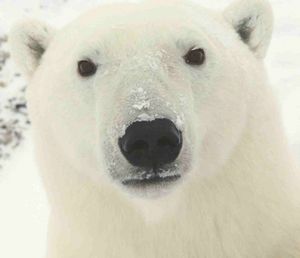Polar bears are a very important indicator of how the arctic region at a whole is doing. This is true for most top predators in ecoregions but especially true for the polar bear. If polar bear populations begin to decline it is often a sign that there is a problem somewhere else in the arctic as well.
Physical Description
Polar bears have two layers of white fur and black skin. The bottom layer is for keeping warm and the top layer keeps them dry. They weigh 780 to 1,500 pounds and are 6.5 to 9.8 feet long. The largest polar bear ever recorded was 2,210 pounds. Female polar bears are usually half the size of the males except when they are pregnant. They have dark brown eyes and a dark brown or black tongue. Their paws are about a foot long across but their tail is only 2.8 to 4.7 inches long. Their paws distribute their weight evenly which helps keep the snow and ice beneath them from breaking and are covered with papillae, tiny, soft growths that increase friction to prevent slipping. They have short solid claws, adapted for walking on ice and climbing steep banks. Polar bears have 42 teeth. Their back teeth are jagged and sharp. Their canines are larger and sharper then those of grizzly. Oddly, however, they tend to swallow their food in large chunks rather then chewing it up well.
Diet and Hunting Habits
Unlike most other bears polar bears do not eat many berries and the like, only when their main food supply is severely low. Their main diet consists of ringed and barbed seals although they also eat harped, hooded and ribbon seals depending on where the polar bears are located. Polar bears will also feed on carcasses of large mammals they find such as beluga whales, walruses, narwhals and bowhead whales. Occasionally polar bears even hunt and kill beluga whales and walruses. When desperate and hungry polar bears will resort to eating muskox, reindeer, small rodents, seabirds, shellfish, fish, eggs, kelp, berries, and human garbage.
Polar bears eat an average of around 4.5 pounds of meat every day. However, the polar bear doesn’t necessarily eat every day. It may eat a seal weighing 120 pounds in one day. This could last for many days. However, it must also eat more to store up fat reserves for the winter. It’s body processes and used 97% of the fat and 84% of the protein in the meat it eats. This is a lot compared to most animals. Also, it’s stomach can hold food equaling 15 to 20% of its own body weight. Polar bears will often take a swim or roll in the snow to get clean after eating.
A polar bear will often catch a seal only once every five days. Only around 2% of hunts by polar bears are successful and they spend at least half their time hunting. The most common method of hunting employed by polar bears is termed still hunting. A polar bear uses its very keen sense of smell to locate a seal breathing hole (a place where seals surface to take a breath). It crouches out of site and waits till it smells the seal surface. It then rushes with astonishing speed and grabs the seal, dragging it out of the water. It bites the seals head or body, killing it. This method normally takes about an hour but polar bears will wait much longer if they have to. Polar bears also hunt by stalking seals that are resting on an ice pack, uncovering seal birth lairs and by scavenging.
Reproduction: Producing Future Generations
Females start reproducing at 4 or 5 years old, but the males do not start until 6 years old. Breeding takes place from March to June. The males sniff out the females to mate with. If two males find the same female they will fight over her. A male will stay with a female for about a week before leaving in search of another mate. While pregnant a female polar bear will eat enough to double her weight. This is needed to provide enough nourishment, through suckling, throughout the winter after the cub is born. Cubs are born between November and February. Polar cubs will wake up periodically throughout the winter hibernation (only pregnant polar bears hibernate) to nurse then go back to sleep. While in what is referred to as a maternity den the female’s heartbeat with drastically slow down from about 46 to 27 beats per minute. Polar bears usually produce two offspring and at the time of birth they are about the size of a rat. However, by spring the cubs will have gained around 20 pounds. Cubs stay with their mother for about 2 years. Then the female will find another mate and reproduce again. This cycle continues until death. Polar bears can live 25 years. It is believed that most polar bears in the wild die from starvation because old polar bears have too much difficulty hunting.
The Past and Future of Polar Bears
During the Pleistocene period, 1.8 million to 11 thousand years ago, polar bears evolved from brown bears. They adapted to live in the arctic where temperatures never raise above 50 degrees Fahrenheit in the summer and usually fall below -20 degrees Fahrenheit in the winter. In the 1600s and through to 1973 the polar bear population was drastically decreased by excessive hunting by hunters and trappers from Europe, Russia and America. In 1973 a polar bear conservation international agreement was signed regulating hunting.
Currently the polar bear population is about 20,000 to 25,000. More then half the populations of the 20 sub-populations of polar bears are in Canada. Evidence of polar bear populations are present all the way to the north pole. Although the overall numbers of polar bears are once again stable some of the sub populations are stable, some are increasing and some are decreasing. In 2005 polar bear status was changed from least concern to vulnerable. The polar bear population is expected to decline by 30% in the next 30 to 25 years.
Source:
http://www.panda.org/what_we_do/where_we_work/arctic/area/species/polarbear/population/



